The Toaster Project
Posted in: Uncategorized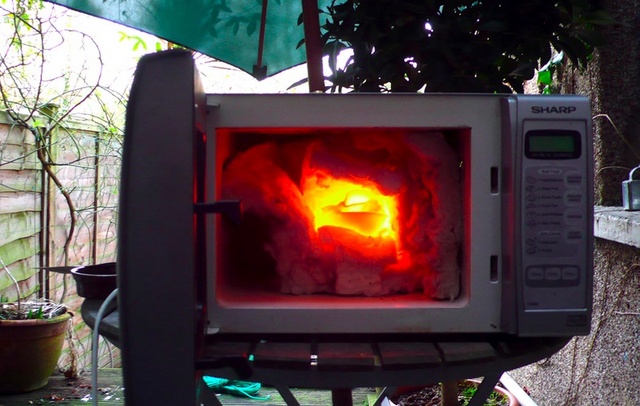

The largest part of the pharmaceuticals and chemicals we take go through our bodies and eventually end up in waste water. As water and waste treatment plants haven’t been designed to filter them, the content of our medicine cabinets are eventually passed into the water supply. In London, tap water comes from surface water which implies that traces of our medicine can end up in our drinking water. This results in local differences in tap water, based on the food and drugs we ingest.
Tuur van Balen, one of the graduates of Design Interactions at the RCA, decided to explore this issue in a project which imho had the perfect balance between speculation and solid anchorage into reality.
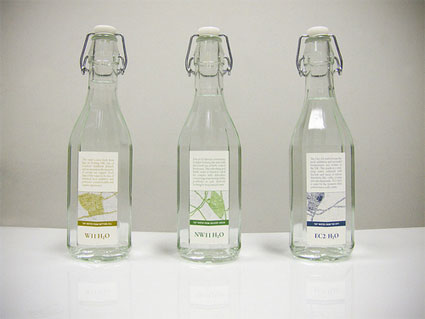
The way people live and behave in each zone of London can be reflected in the quality of the tap water. Tap water in London Notting Hill very probably benefits from the high density of organic shops found in the area. Tap water in the city of London is presumably enhanced with all kinds of stimulants, from caffeine-rich drinks to cocaine. Golders Green which houses an important Jewish community can be expected to ‘produce’ a very fertile water due to the low concentration of people taking anti-conception pills.
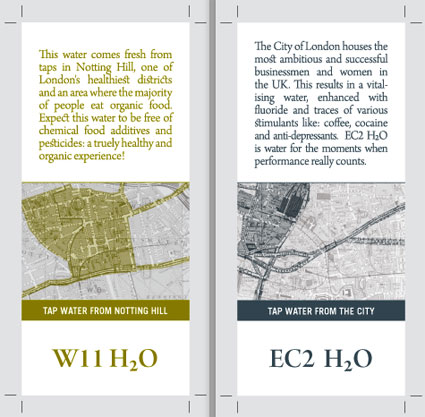
Back in January, at the opening of the department work in progress show, Tuur presented My City = My Body, the first chapter of this research into future biological interactions with the city and more precisely into how the increasing understanding of our DNA and the rise of bio-technologies will change the way we interact with each other and our urban environment. He offered tap water to the visitors of the show and asked them to donate a urine sample along with their postcode. The samples, their biological information and postcodes were then added to a map of London which reveals potential local city-body ecologies or biotopes.
The next step is a website which helps London inhabitants describe, speculate on, map and share what they think are the unique characteristics of their tap water. The map thus created reveals potential local city-body ecologies, or biotopes. The system will also generate a custom-made label which you can download if you want to sell your own tap water.
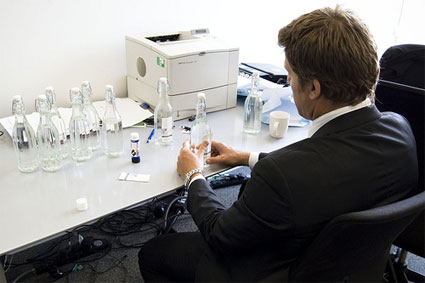
Filling the bottles in the City…
That’s what the designer did. He went to the hip and organic-addicts frequented Broadway market in Hackney to set up a stall, offer people to “buy” bottles of tap waters, branded with the London area they came from and engage in a discussion about the possibility of new urban biotopes.
selling tap water on Broadway Market from Tuur Van Balen on Vimeo.
You can find various websites which details the quality of various tap waters. But most of the systems employed to analyze water do not check for say, anti-depressant substances or cocaine. What if biotechnology could provide us with cheap detectors?
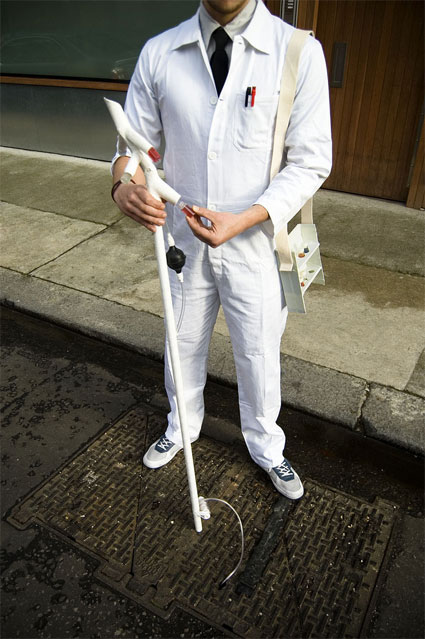
With the help of bioengineer James Chappell, Imperial College, Tuur developed the concept for a Urban Biogeography tool. The instrument would enable anyone to study the distribution of urban biodiversity over space and time by monitoring sewage. With the tool, a tiny amount of sewage can be pumped up and scaned for different pharmaceutical and chemical traces, without having to lift a manhole cover.
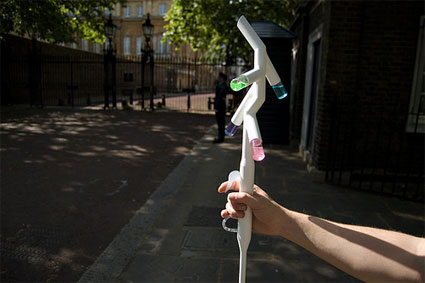
Using synthetic biology and in particular the biobricks tools, bacteria are programmed to become cheap biosensors. The bacteria-sensors, housed in the small transparent compartments, change colour when oestrogen, antibiotics, Viagra or Prozac are detected in the water. Since synthetic biology is both open source and modular, this instrument can be redesigned to detect other chemicals by any Urban Biogeographer, even amateurs as the technology is becoming increasingly accessible. The set of data thus obtained can be used to influence healthcare or property prices in the area, that of course would be the ideal scenario…
All images courtesy of Tuur van Balen.
Related: 24c3: Programming DNA – A 2-bit language for engineering biology, Designer Microbes.
Funniest project seen at the RCA show. You won’t need my explanation, just have a look at the video:
Signs of Life was created by Freddie Yauner (of the highest popping toaster in the world fame) a graduate of the Design Products department, Platform 11 . Because it was exhibited where you’d expect to see an emergency exit sign i did believe that it was a real one for a moment.
Instead of following my natural instinct and turn this blog into the usual happy bordello where unrelated posts follow one another, i’m going to try and focus my reports over the next few days on the projects i saw last week at the RCA Graduate Summer Show in London.
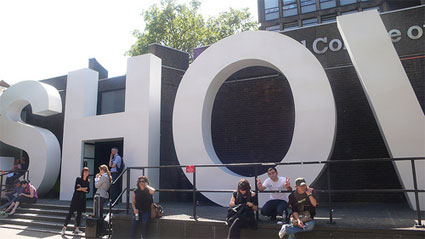
Revital Cohen‘s final project at the Design Interactions department looked at how cross-breeding man with machines or other species can open up new design opportunities and a space for debate (see her previous project the Telepresence Frame.) I realize that most of the readers are familiar with this concept of ‘design for debate’ but to avoid any misunderstanding, let’s just remind that design for debate explores how design can be used as a medium to draw attention to the social, cultural and ethical implications of new technologies. The resulting design proposals do not provide answers, but they make complex issues tangible, and therefore debatable (via).
Revital’s Life Support project looks for way of disconnecting people from the therapeutic machines and cold technologies they are harnessed to. Assistance animals – from guide dogs to psychiatric service dogs and other emotional support animals – unlike machines, can establish a natural symbiosis with the patients who rely on them. Would it be possible to go a step further and transform animals into medical devices?
This project proposes using animals usually bred commercially for consumption or entertainment as companions and providers of external organ replacement, offering an alternative to inhumane medical therapies.
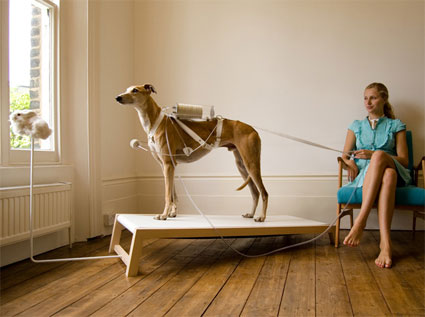
The first part of the project revolves around a concept of Respiratory Dog. Today greyhound racing remains a very lucrative business. Tens of thousands of these dogs are bred annually in an attempt to create the fastest dogs. Most of them are killed if at any time it is determined that they don’t have potential to be good racers. The dogs are a mere commercial product and because they constitute a major expense, many of them are killed as soon as it is determined that they don’t have value anymore as a racer at a track.
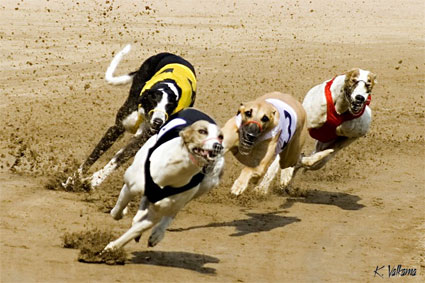
Greyhound race. Image Valkama
In 2003 alone, an estimated 7,500 to 20,000 greyhounds were euthanized simply because they couldn’t run fast enough. There are more heart-breaking (even for me who could never be accused of being dog’s best friend) facts about their sad existence on the PETA website.
In Revital’s scenario, a pedigreed greyhound spends the first twelve months of his life being trained by the racing industry to chase a lure. Over the next three to five years the dog spends his days at kennels and is taken racing weekly to make profit for its owners.
So far, nothing new. However, as soon as its time has come to retire from the racetracks, the greyhound is not euthanised (as happens nowadays to thousands of retired greyhounds), it is collected by the NHS and goes through complimentary training in order to become a respiratory assistance dog.
When training is completed, the greyhound is adopted by a patient dependent on mechanical ventilation and begins a second career as a respiratory ‘device’. The greyhound and its new owner develop a relationship of mutual reliance through keeping each other alive.
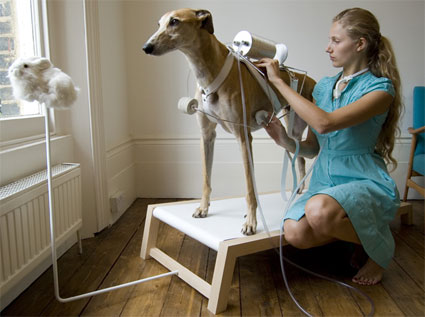
A new apparatus is used to converts the greyhound’s lung movement into mechanical ventilation: the dog is fitted with a harness and placed on a treadmill where it will start running, stimulated by the same mechanical lure employed in its previous training. The treadmill functions as the interface and on/off switch. The harness uses the dog’s rapid chest movement to pump a bellows that pushes air into the patient’s lungs.
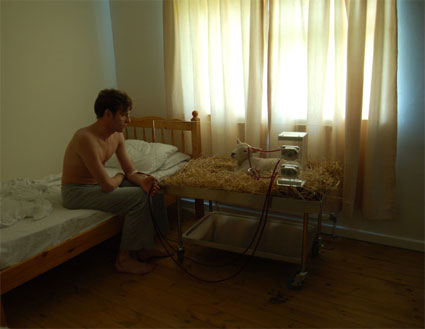
A second scenario envisions substituting a dialysis machine with a sheep. The concept is inspired by several advances of science such as the creation of cows and sheep cloned to have human blood in their bodies. Much research is also carried out to design animals which would carry organs compatible with humans. When one organ would be needed for transplantation the animal would probably be killed to provide the precious body part.
On the other hand, current, mechanical, dialysis treatments are far from being perfect.
Revital’s scenario imagine that, in the future, a patient suffering from kidney failure would give a blood sample to lab scientists who then isolate in the genome the regions that code for blood production (bone marrow tissues), and immune response (the major histocompatibility complex), extract the genome from the nucleus of a somatic cell taken from a sheep and substitute the corresponding regions of the sheep’s genome with the DNA from the patients’ genome.
This recombinant DNA is then inserted into the nucleus of a pre-prepared sheep egg cell. After cell division in the egg is initiated, the egg is implanted into a surrogate ewe which will eventually give birth to a transgenic lamb.
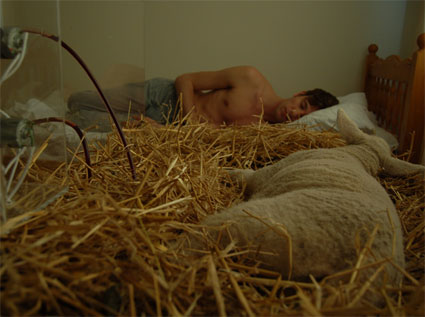
During the day, the dialysis sheep roams in the donor patient’s back garden, grazes to cleanse its kidneys, and drinks water containing salt minerals, calcium and glucose.
At night, the sheep is placed at the patient’s bedside. The transgenic sheep’s kidneys are connected via blood lines to the patient’s fistula (a surgically enlarged vein). During the night, waste products from the patient’s blood are pumped out of the body, filtered through the sheep’s kidney and the blood is returned, cleaned, to the patient.
This happens over and over again throughout the night. The day after, the sheep urinates the toxins.
Related: Utility Pets, myBio dolls, The Race, health benefits of robotic pets.
Another project from the RCA Design Interactions show. This one made me laugh so much:
In wealthier neighbourhoods, the size of the house and how well maintained the garden is, often represents status.
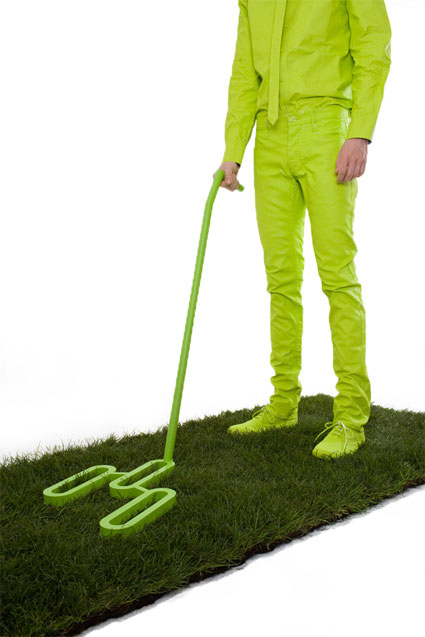
The Grass Scanner is a device designed by Alice Wang to measure how green the grass is. Using 3 Pantone Color Cue devices, it takes reading from 3 random patches of the grass and outputs a Pantone colour code for one to compare. With the codes, one can refer to the PARKTONE cards which contains average grass colours of Royal Parks and other green areas in the UK for people to match up with their own garden.
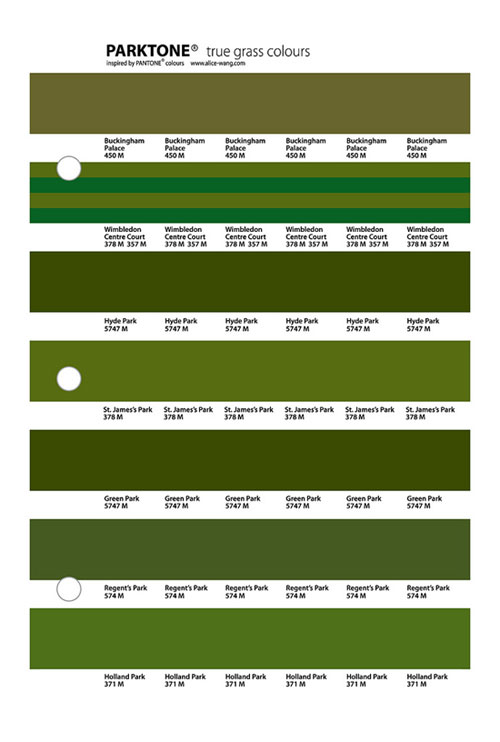
As grass condition in different areas of a given park may vary, each area was measured several times before an average of the data was used to create the PARKTONE card.
Relate: Mugs for a perfect tea.
News from the graduate summer show at the Royal College of Art in London.
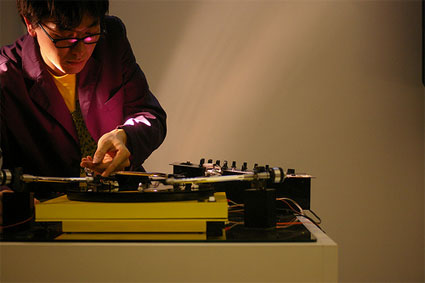
Yuri Suzuki and the Prepared Turntable
Quite a few projects made my day over there. The ones of Yuri Suzuki for example. That guy is so talented it should be illegal. He’s an artist, musician and now a fresh graduate from the Design Products department. His project is concerned with revamping and giving new forms and meanings to the almost obsolete turntable, a device which very few of us still have in their house. We don’t buy disks of CDs anymore either. Nowadays music is more abstract and immaterial than ever. Sound has been reduced to data.
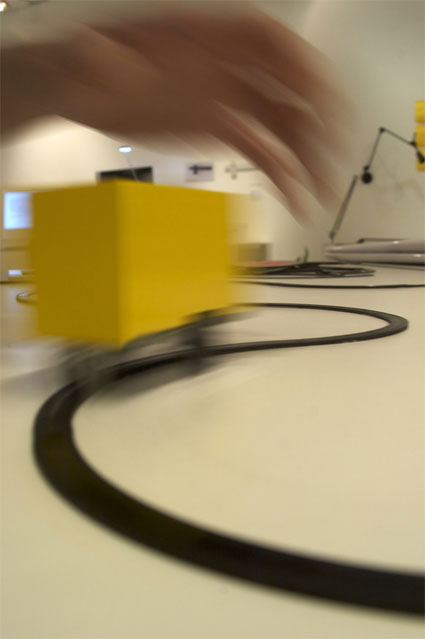
Sound Chaser
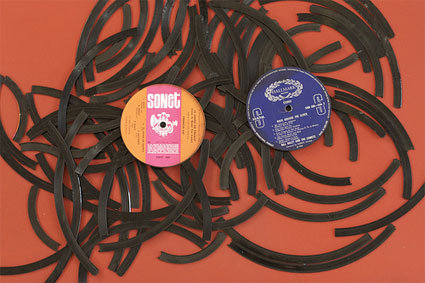
Sound Chaser
Sound Chaser looks like a little toy train that rides on record rails. You can align and connect each chipped pieces of second-hand records one to another and compose a new track that the train will play.
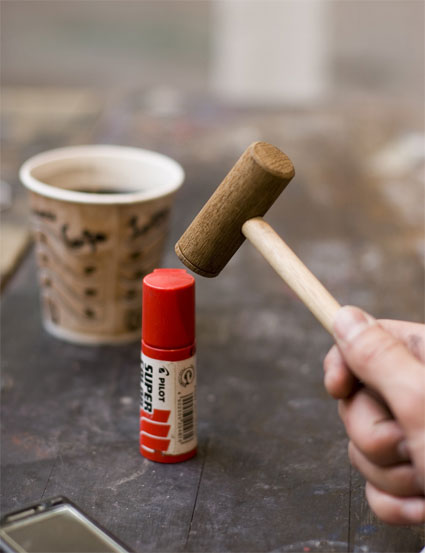
Tip Tap
The TipTap, developed in collaboration with Bahbak Hashemi-Nezhad, is a little hammer that reveals the dormant sounds around us.
A small metal tapper housed in the object taps out a rhythm on any object or surface that you hold it near to. The rhythm is set either by the user or can be defined by the controller. Alternatively, a beat can be taken from your favourite record, allowing you to play along while keeping perfectly in time. The TipTap can also synchronise with other users to make a social tapping experience.
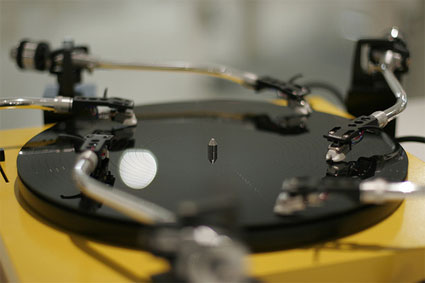
Prepared Truntable
The Prepared Turntable is an analogue answer to the digitalized DJ. The turntable has 5 tone arms, each of which can have its volume controlled by its own fader. Users can make or play music with special loop groove records.
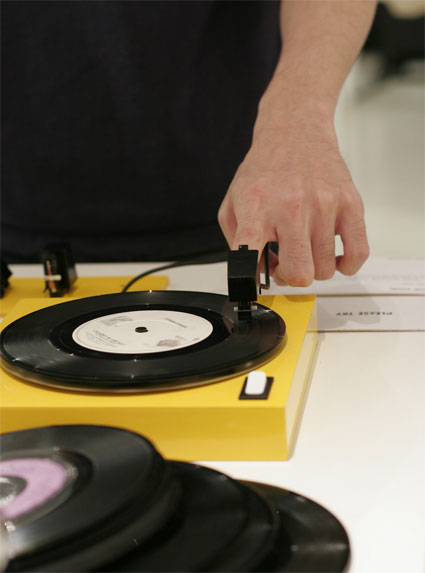
Finger Player
The Finger Player is a wearable record player. Insert your fingers into one of the little rings, play the record just by holding your hand over the disk and feel the physicality of making sound.
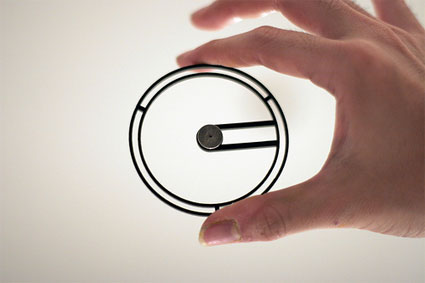
Sound Jewellery
Sound Jewellery conceives sound as something precious that you can offer to a friend or wear as a memory of a shared laugher, a romantic conversation, any sound moment from your daily life. The record is made up of components which of course you can play but they can also be worn as bracelet, brooch or other pieces of jewellery.
Related: Turntable Orchestra, Computer/Turntable hybrid, The Turnatable Microwave, video turntable, the Tri-phonic Turntable, etc.
All images courtesy of Yuri Suzuki.
The works are on view at RCA until July 5, 2008.
Another prototype spotted at the RCA work in progress show a few weeks ago in London. This week: In Memory of the Sparrow
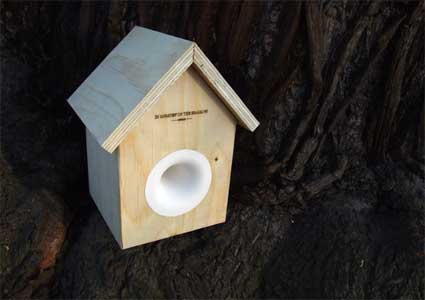
As new wireless technologies are introduced, using various frequencies and power levels, an invisible energy is increasingly altering our habitat. There are no conclusive results from research to indicate the influence of this energy on our health or our environment, but studies have shown that sparrow populations are decreasing in areas that are affected by electromagnetic communication.
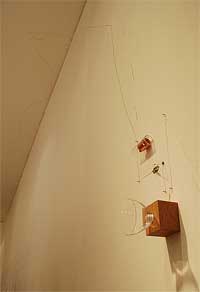
In her scenario, Cathrine Kramer portrays a day when we will walk through a park and meet with an eerie silence. All the birds have disappeared due to an increase of electromagnetic radiation in the urban environment. Inspired by the ‘foxhole radio‘. These simple radios, popular among soldiers during the World War II, need mainly electromagnetic waves as a source of energy.
The object harnesses the very force that drove birds away, and transforms it into subtle bird-like sounds, acting both as a comfort to those who want to remember the sparrows, but also as a poignant reminder that our surroundings contain a level of complexity that surpasses our senses. They are “memorial to the sparrows.”
I asked Cathrine how exactly the bird-like sound was created. “In the exhibition the bird sound was orchestrated, because to work the radio would have to be grounded and this was not possible within the exhibition space,” she explained. “However, in the future scenario I envisioned, these memorials would be mounted to trees and tuned to pick up bird sounds transmitted on an AM frequency bandwidth. The antenna would be a long wire spiraling up the tree to pick up the radio waves.”
All images courtesy of Cathrine Kramer.
Animals have senses beyond human experience, they instinctively feel approaching tsunamis through low frequencies, communicate through pheromones or can navigate through magnetic fields.
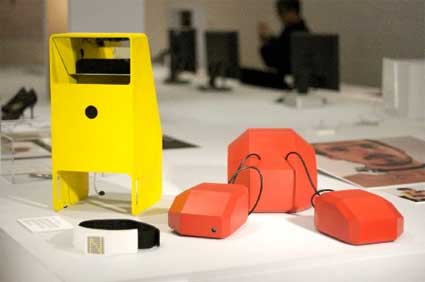
Students of Design Interactions Chris Woebken and Kenichi Okada, in collaboration with MBA students from the Oxford Said Business-school, have been developing a series of sensory enhancements toys for children to experience “animal superpowers.” Each prototype allows the kid to change perspective or feel empathy with animals.
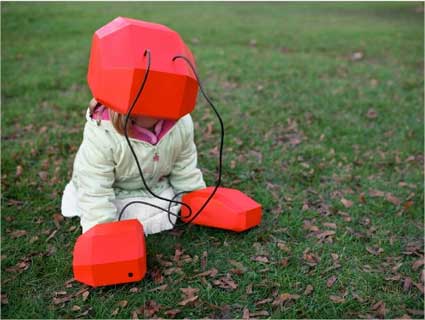
At the work in progress show of the Royal College of Art in London a few weeks ago there were showing 3 of their prototypes:
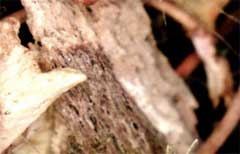
The ground as seen through the “Ant” apparatus
Ant – feeling like an ant magnifying your vision 50x through microscope antennas on your hands
Bird – gaining a sense for magnetic fields
Giraffe – a child to adult converter changing your voice & perspective
They are also developing Elephant shoes that pick up transmitting vibrations from fellows and a head mounted Theremin (!) to provide children with an enhanced spatial vision similar to the one of an electric Eel.
I played with the ant and giraffe devices while visiting the RCA show and found out that the objects do exactly what their description says: i felt humbled by the ant devices (i could not see anything of what was around me but could perceive all the tiny cracks and details on the surface of of the table i was exploring) and while doning the giraffe helmet i could only perceive the head of the tallest people in the room. Anyway, time for a few questions to Kenichi and Chris:
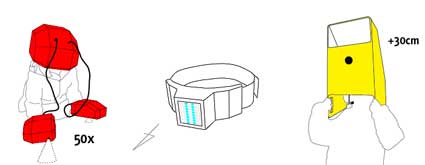
How does the Bird device work?
K&C: Birds find direction through sensing geomagnetic fields to find their way migrating from their summer territory to where they are spending the winter months.
Rather than translating the sense of geomagnetic fields literally, we designed a device that can be set to basic children’s needs sensing the direction of home, icecream-shops or your friends.
Tiny motors in the device create a haptic sensation on the skin when you tune into the direction and create a new relationship to your environment. It not just creates a haptic sensation for yourself but as part of the superheros it also displays the direction and visualizes it to your friends.
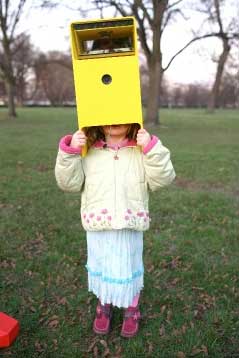 Which technique did you use to change the voice in the giraffe helmet?
Which technique did you use to change the voice in the giraffe helmet?
K&C: We are using a telephone voice changer to make a kids voice sound like an adult.
Has working on this project taught you something you were not expecting about body perception and possible future body extensions?
K&C: All the devices in this series are working experiential prototypes so we could test the devices with kids. We were quite surprised how extreme the ant device changes the children’s behaviors. Even a hyperactive kid moves very slow because the new 50x scale makes you feel sick if you would move at normal speed.
We are interested in perception and sensory enhancements for the body and we are also considering a series of toys that uses bio-sensors and can tune into biochemical animal communication.
C: The animal project inspired me to explore new ways of interacting with our instinctual animal-self, taking it from the toy level to an adult training tool. Our senses evolved to operate in a networked information age and the sense of smell for example is currently degenerated because we have fire-alarms. Evolutionary our emotions are still controlled with the reptile part of our brain. I am exploring how networked technology and human augmentation training tools can create a new awareness, augment instincts and train new reflexes and for today’s survival.
Thanks Chris and Kenichi!
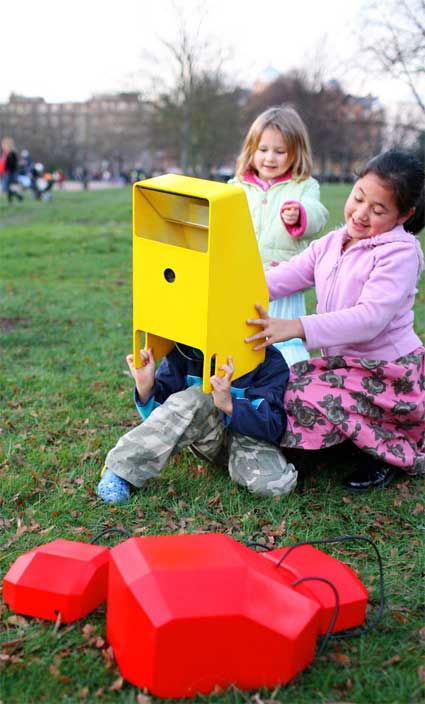
Images by Chris Woebken.
UPDATE:
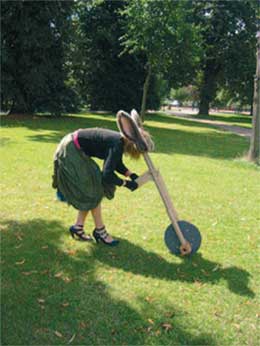 Jim Rokos just told me about a low-tech device that, although it does not enhance our sensory range like the Animal Superpowers project, alters a user’s perception of the space (in this case Kensington Gardens in London) by giving the sensation of being a rabbit.
Jim Rokos just told me about a low-tech device that, although it does not enhance our sensory range like the Animal Superpowers project, alters a user’s perception of the space (in this case Kensington Gardens in London) by giving the sensation of being a rabbit.
Designed by Rokos in collaboration with in collaboration with Kathrin Bohm and Andreas Lang, the object lowered your vision to ground level, and outwards, by the use of periscopes. The device was set off centre on a wheel to create the sensation of hopping.
The device comes with ears and a tail, so that onlookers can also understand the product’s purpose.
A day of conspiracy theories…
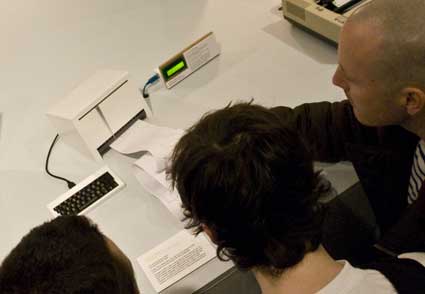
Mi-5 Persecution is the subject line of a series of Usenet posts, originated by Mike Corley, an IT specialist living in London.
His messages usually detail how British intelligence has bugged his home and is sending people to follow him around and harass him. He has also claimed in his posts and on the pages of his own website that television personalities are mocking him or talking about him in code and are part of the MI5 conspiracy. According to him, MI5 with the assistance of the US has started in August 2005 to use a mindcontrol technology which not only reads his mind but can also send voices and thoughts on his mind. This has led to claims that he has mental health issues. Corley has been banned from posting through Google for his abuse of Usenet bulletin boards and has been similarly bounced from most ISPs in England. His story has even been turned into an opera last year.
In the past, his posts were relatively easy to filter out, due to his similar subject lines and email address. However, at the start of 2008, he began a series of posts that avoided filters through sporgery and slightly varying his subject line of “MI-5 Persecution”. The regular expression Subject: {M[‘,-`. ]I[‘,-`. ]5[‘,-`. ]P} will filter this.
Corley Radio, by Design Interactions students Tommaso Lanza and Ross Cairns, is a combination of printer and a radio. It prints out specific words picked up while continuously scanning public and commercial radio stations. Any keywords can be programmed, but in this case they relate to the ongoing Mike Corley story about the MI5 (the UK’s counter-intelligence and security agency) trying to ridicule him through radio and television broadcasts.
The designers imagined that Mike Corley would use the radio to keep track of who is talking to or about him, to help him find all possible conspiracies against him, that he by himself could never possibly detect.
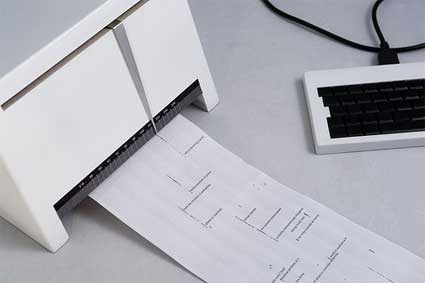
3 questions to Ross & Tommaso:
Is it a working prototype or a concept?
Mechanically it works, however we couldn’t get access to suitable voice recognition software, so for the purpose of the exhibition we faked the print outs based on details from the MI5 Persecution Reports. These are written reports from Mike which he spams to the internet daily at a truly astonishing rate (we’ve set up a crude tracking system recording the number of his posts found on the internet – we know many companies who would love to have this sort of ranking on Google).
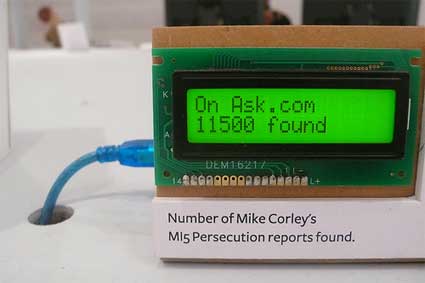
Why choose Mike Corley?
Sometime ago we stumbled across these reports from Mike on Usenet and we started to get obsessively curious as to what they were about. The radio concept alone could be used by anyone. Here in London we could imagine Amy Winehouse or her family using it. A day never seems to go by without some form of unintended tabloid focus on them. However, during this project the story around Mike Corley became increasingly interesting.
I had never heard of that man before so i looked for information about him online and felt very sad for him. Have you tried to get in touch with him?
We know what you mean, it is a strange space we are operating in. This is about a person who is very real and an active part of the ‘uk.misc’ Usenet community. Many of the active community’s members have met him. We have not contacted him (yet). He is constantly receiving nasty replies to his posting from webmasters or forums users. Should we be part of this or passive? Mike is manipulating technology to make his message public and we are feeding off this, highlighting it and using it; but as designers we are very clear about our role. We are not passing judgment on Mike but leaving the project open for interpretation.
Thanks Ross & Tommaso!
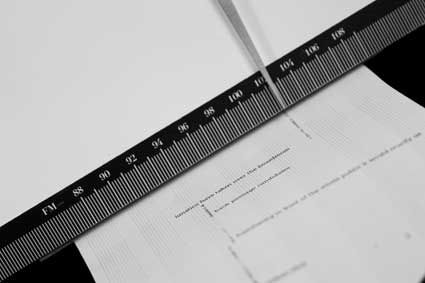
Images 1, 2 and 4 courtesy of the designers.
The theme of Susanna Hertrich‘s thesis at the Design Interactions department, RCA, in London, is a reflection on humans and animals in the context of “Human Enhancement”: How much do we want to borrow from animals and what are the risks this would involve? How much of the animal is still living inside us? How much of the original animal that we once were has been has been lost in the evolution process?
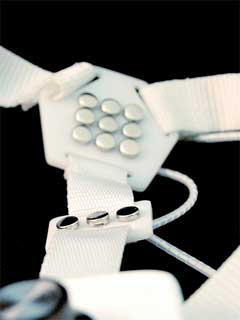 The project that Susanna was showing at the work in progress show a few weeks ago is the Alertness Enhancing Device.
The project that Susanna was showing at the work in progress show a few weeks ago is the Alertness Enhancing Device.
The risks we fear the most are often the ones most unlikely to be encountered. The human animal has lost its natural instinct for the real dangers. When worn directly on your skin, the Alertness Enhancing Device will act as a physical prosthesis for a lost natural instinct of the real fears and dangers that threaten us – as opposed to perceived risks that often cause a public outrage.
The idea is it stimulates goosebumps and shivers that go down your spine and make your neck hair stand up, waking up the alert animal inside. You become more alert and ready for the real dangers in life.
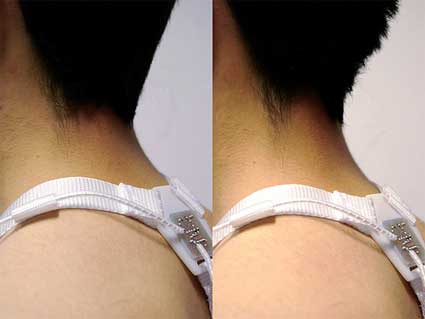
Before / after
Why would we need such device? Studies on risk perception show that many people are seriously afraid of terrorist attacks and their anxiety is heavily exploited in media and politics. A look at statistics shows that the probability of becoming a victim of terrorism is quite small. Meanwhile other real hazards are perceived as rather uninteresting and raise far less fear, for example environmental pollution or car traffic.
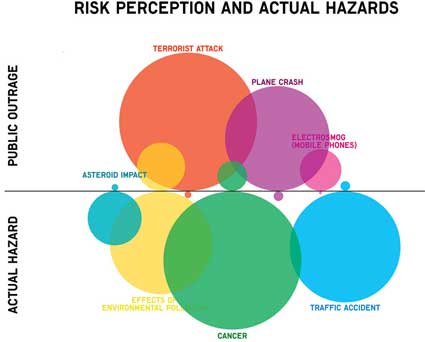
While we consciously know what are the things that really threatens us, we tend to dedicate much more of attention to spectacular disasters with many deaths.
That’s when the Alertness Enhancing Device comes in. If you feel dispassionate and bored when reading news stories about another environmental pollution scandal, it’s probably time to turn the dial of the device on.
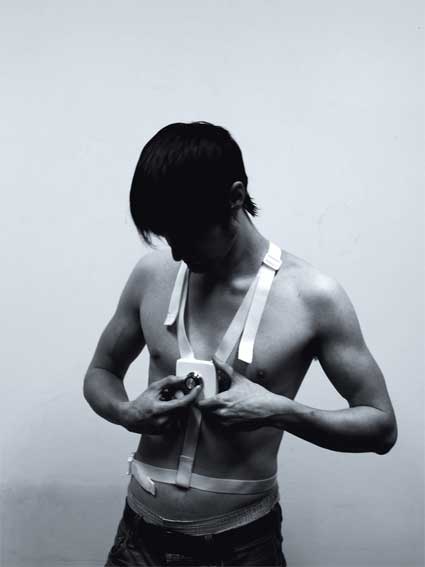
And since it’s a wearable device, you can even alert yourself in any situation, even in public contexts.
“The project is pretty much in a work-in-progress state,” explains Susanna. “What I’ve shown in the exhibition was “just” a form prototype, but I have been experimenting with micro-current stimulations. This is quite unpleasant if placed between your shoulder blades and on your neck, but not as “in your face” as a plain electrical shocks. And…it allows you can alter the current, so you can decide how much you can take for now. Which is how I intend this first prototype to work.”
How is the project going to evolve?
“For the next version I plan to work with much more sophisticated sensations on the skin than microcurrents. The project now has shifted more into “skin as interface” and I plan to play with “apparent movement” sensations and “somatosensory illusions” as beeing explored in haptic research. I’m currently in touch with scientists in London and Tokyo to get an insight into how these things work and how I can use those techniques.
I’m not sure if the second version will work the same way as the first prototype. Probably the second version will be triggered automatically by data that is collected from some other place. I see it rather as “desktop device” than a wearable, and maybe it is something next to your door that you want to check before leaving the house. But I need decide on all the details during the next weeks…”
Thanks Susanna!
All images courtesy of Susanna Hertrich.
Ticker Tape is an internet radio for people who suffer from Euphobia, “a persistent, abnormal and unwanted fear of hearing good news”. Designed by Will Carey, it was exhibited at the work in progress show of the RCA in London a few weeks ago.
Ticker Tape is a working prototype that simulates the interaction but as this was a project done in only two weeks some details are still to be fixed. Using RSS feeds, Ticker Tape scans for light-hearted news stories from around the world broadcasting them to the listener who can manage the content via the Ticker Tape website (still in construction).
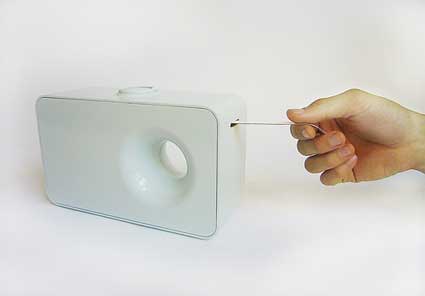
Activating the radio
Pulling the cord allows the user to choose the duration of the broadcast.
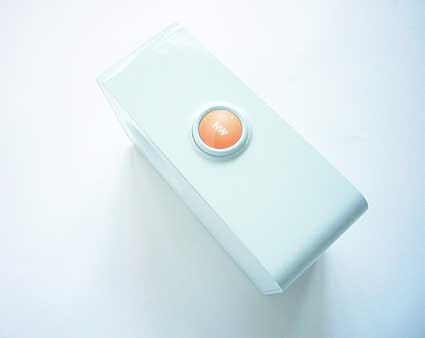
Tuning direction
The origin of the news stories can be selected by the dial on the top of the radio.
This project explores playful interfaces for the future of digital radio, and is part of wider ongoing research.
As Will was in Tokyo when i visited the show, i wrote him to get more information on the radio:
The first time i read the description of the project, I thought the radio was meant for people who are afraid of bad news. But it is the exact opposite. You created it for people suffering from “euphobia”. Do such people really exist?
Yes they do, although very few people experience this condition. The intention was to use a phobia as a starting point for the design process, and the radio was inspired by euphobia, “a persistent, abnormal and unwanted fear of hearing good news”.
So why not make the radio that everyone would expect, the one that people who hate hearing bad news would want to buy?
I think this would leave less to the imagination. I wanted to suggest how someone who really suffers from such a fear could overcome it, either via team therapy or by getting used to hearing good news once they had had the initial support from a therapist. By pulling the tape the person can acclimatise themselves to hearing good news in small measured doses.
While the original intent is to cure a phobia, it can also be used to create more insightful solutions for interaction with technology. (This is not to say that one is trying to make light of what are indeed serious and real fears. But changing oneÂ’s mindset as a designer and moving away from marketing-driven design and thinking about solutions from a completely different perspective, can encourage new interactions and designs to emerge.)
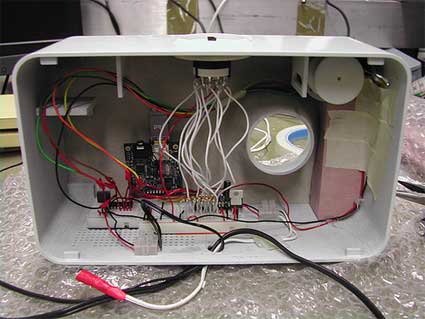
Assembling the prototype
Ticker Tape has a very sleek, pure and shiny design, does this reflect its own “mission”?
The design has considered a neutral and inviting form, which means you almost have to encounter the object and discover out how it works, yet there are some cues and signs that it is a domestic product. I wanted the radio to be made from ceramic – the prototype is plastic, perhaps that is why it’s so shiny. The void running through the object is for the speaker and the overall form is inspired by an old Braun SK25 radio designed by Dr Fritz Eichler in 1955.
Thanks Will!
All images courtesy of Will Carey.
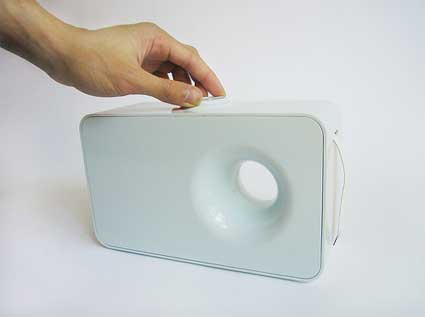
Tuning the radio
My favourite project at the Royal College of Art work in progress show this year was by an architecture student from unit ADS.3 (tutors: Fernando Rihl, Kirsteen MacKay).

In Dog Eat Dog, Jordan Hodgson asks some though-provoking questions:
To what extent as a society are we willing to pursue the sustainable ideals of the 21st century? Are we willing to cross ethical boundaries and venture into taboo markets for these purposes?
2127 dogs and 74 cats are destroyed annually at Battersea Dogs & Cats Home (BDCH).
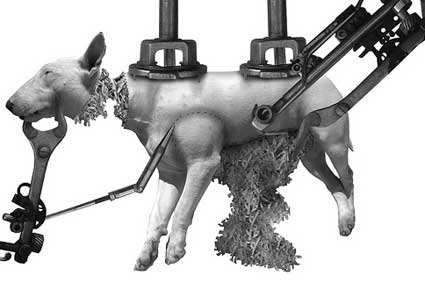
The biomass (70 478 kg) produced needs to be disposed of in a responsible, ecological fashion because of the many harmful agents given off when biological material decomposes. BDCH currently cremates these pets.
Would it be possible to regard this biomass waste as an untapped and positive resource waiting to be exploited, could it become both beneficial and complimentary to the centre? Hodgson proposes a solution to the issue which involves working simultaneously with the BDCH existing facilities and introducing new subversive and hidden elements such as turning the body of cats and dogs into pet food, setting up a dog fight betting business and developing the taxidermy potential of dogs. His scenario would turn a non-profit organization (BDCH) into a profitable one.
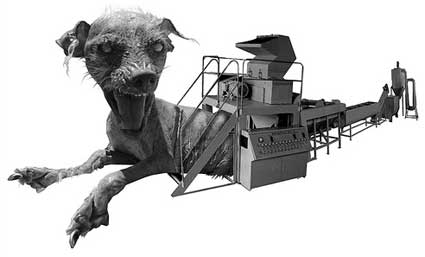
Along his research, the young architect gathered a series of facts and figures:
A dog is worth up to 35x more dead than alive from Battersea. Dogs are worth £85 at Battersea alive. Mounted in a taxidermy shop they are worth up to £3000.
105 068 stray dogs alone were destroyed in the UK last year. That is a 3% increase from the year before. (more details in 2007 Stray Dogs Survey Result Breakdown.)
10% of these animals were destroyed in London.
25% of the breeds that pass through BDCH home are Staffordshire and Bull Terriers.
10 000 dogs and cats (either strays or pets handed over by their owners) pass through BDCH annually.
158 500 cans of dog and cat food are consumed at Battersea each year.
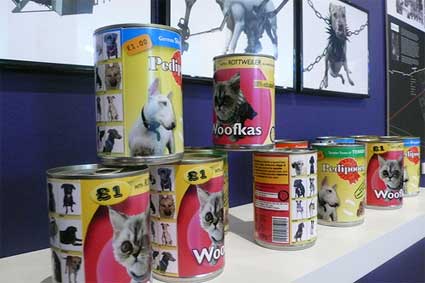
232 447 cans could potentially be produced by using the destroyed dogs and cats. They would feed all the animals living at the center.
5 483 extra cans would be produced that could be distributed for profit from the Battersea shop.
Alongside the existing shop in Battersea, Hodgson imagine that new facilities could open such as a “Taxidermy showcase & shop” to produce taxidermy on site, a taxidermy school and workshop to promote the profession of taxidermy and raise the UK profile. Caning factory producing dog (or cat) meat canned and labeled. A rendering plant to process dead animals into pet food.
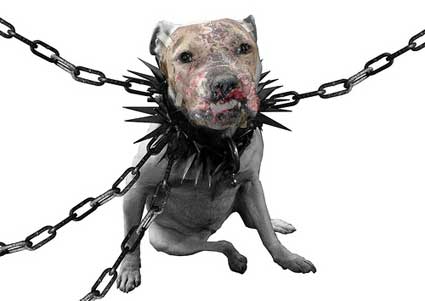
An online market would also be developed. For example, You Tube would be used for the betting purposes of the dog fights.
The recycling of pets is considered a repugnant market with many bioethical factors to be taken into consideration. With 22% of UK households being pet owners can we accept the justification of such a proposal? The project is sustainable but would it be acceptable?

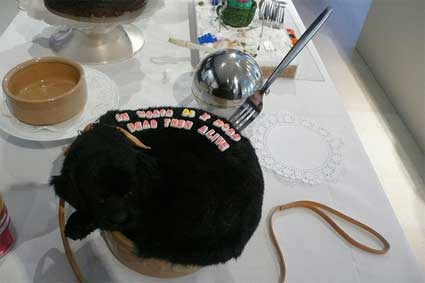
I’m worth 35 times more dead than alive
Images 1, 2, 3, 5 and 6 courtesy of Jordan Hodgson.
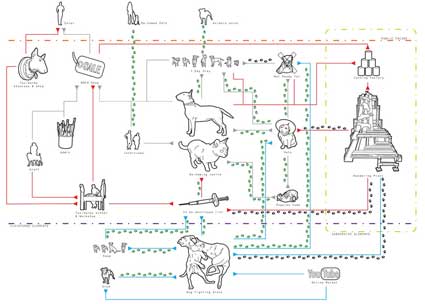
How the re-structured center would function (bigger size)
Related: A German inventor says he’s found a way to make cheap diesel fuel out of dead cats.
The project that Zoe Papadopoulou presented at the RCA work in progress last week show ticks all the right boxes: there’s the knitting, the sense of humour and the techno-induced diseases.
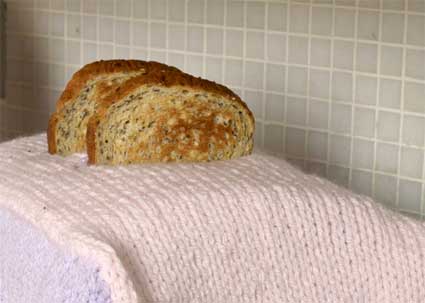
Knitted Shields is inspired by people suffering from electromagnetic hypersensitivity.
The solution imagined by the young designer is to cover all electronic devices in the house with a cozy. By weaving a thin thread of copper in the wool and grounding it, she ensures that the electromagnetic fields are blocked.
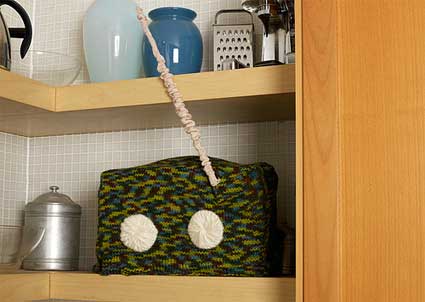
According to the designer, the shields work better on some objects than on others. The microwave and radio cozies for example block the waves very well. It seems to depend on the density of the knits and the thickness of the copper wire.
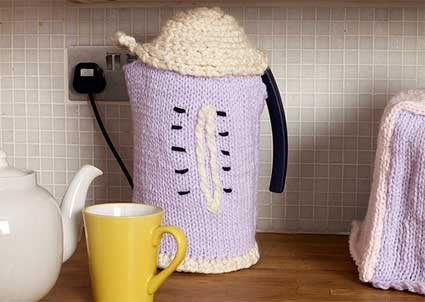
By bringing together ideas about knitting and domestic artifacts, this project challenges the assumption that technologies are taking over our lives, and that we can have no response. It is as much through the process of production, as the protective qualities of the “cosies” themselves, that the knitter feels empowerment and control.
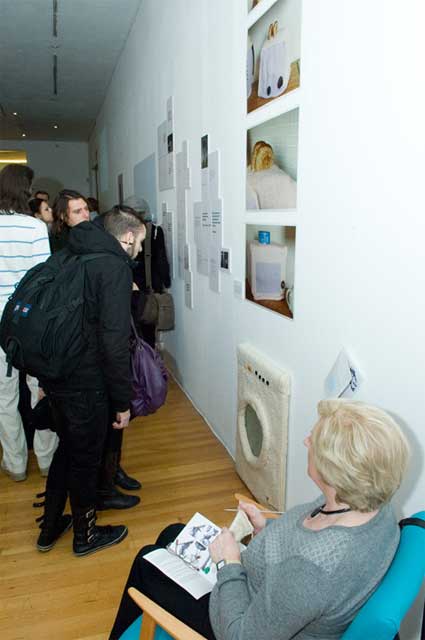
At the show opening, Zoe had a lady knitting with wool and copper wire, who was also available for quick introductions to this technique.
All images courtesy of Zoe Papadopoulou.
One more from the work in progress exhibition at the Royal College of Art in London.
Tuur Van Balen, student of Design Interactions turned his attention to drinking water.
Water service companies add fluoride to the water to reduce tooth decay, in the UK, in the US and other countries. It has also been said that the army in some countries added bromide to drinking water in order to quell sexual arousal amongst male soldiers. Male fish in some area turn female because the oestrogen in birth-control pills ends up in the river.
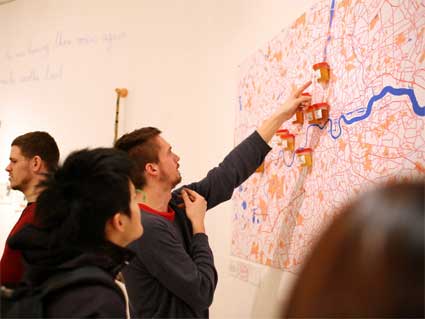
My City = My Body is part of ongoing research into future biological interactions with the city and more precisely into how the increasing understanding of our DNA and the rise of bio-technologies will change the way we interact with each other and our environment.
The first chapter of this exploration of new biological interactions is dedicated to Thames Water, London’s largest ‘drinking water and wastewater service company’. Making use of the work-in-progress-show at RCA, he offered tap water (kindly provided by Thames Water) and asked visitors to donate a urine sample along with their postcode. He added the samples and postcodes to a map of London which contains biological information.
Because i liked his project a lot and wanted to make sure i wouldn’t write anything too silly about it, i asked Tuur to give us more details about his research. I’m passing the microphone to him:
The installation / intervention in the show is part of a bigger, ongoing project called My City = My Body. I’m interested in how cities are not as much made up by streets and buildings as they are made up by our behaviour and experiences. (The London of a design-student, cycling around from Shoreditch to South-Ken is totally different from the London of a banker in a black cab with his blackberry and a loft in Notting Hill) These experiences are heavily mediated by technology, just look at the way mobile communication networks totally reshaped our cities.
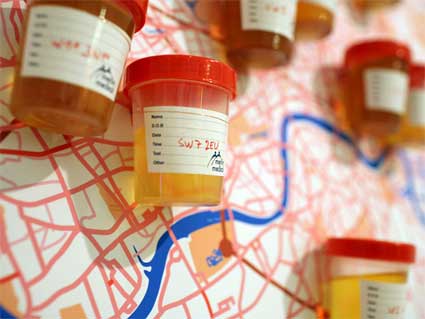
What I’m interested in, is how future technologies might influence our urban behaviour. We’re on the verge of a new area, an area that relies on the understanding of our body and the understanding of our DNA. What does this mean for the cities of tomorrow? Will we have DNA-surveillance and discrimination? Bio-identities and communities? …
The biological map in the interim show was an ‘intervention’ using the show as a platform to get feedback on these ideas. By gathering urine samples, I want to make people think about how their biological waste contains information. Pissing in public might become like leaving your digital data up for grabs, spitting in the streets like leaving your computer unprotected on the internet.
Unfortunately, I was not allowed to test the urine samples in the show. As England is the Mecca of Health&Safety, it was a struggle which took me up to Senior Management to even exhibit my project in this form (“Bio-hazard, sir!”) Continuing this research, I’m trying to contact a laboratory to look at bacteria, how bacteria could be a possible way of transforming our biological waste into information (inspired by Drew Endy‘s BioBricks project) and what the consequences in our everyday lives could be…
Thanks Tuur!
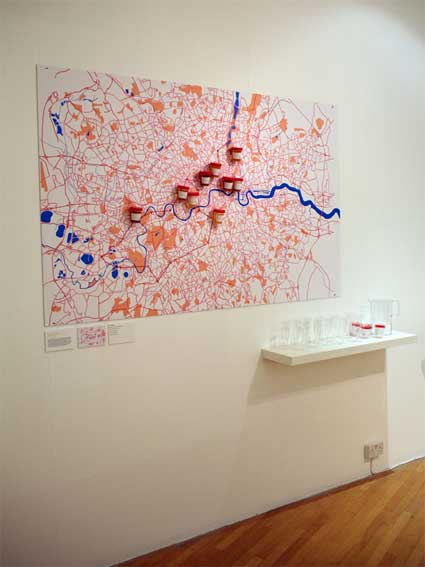
Images of the project courtesy of Tuur van Balen.
As i’m going to spend the next few 24 hours in planes and airports eating crap food, being attacked by some yellowing videos of Mr Bean and cursing myself for not going where i ought to go, i thought i’d leave you with the very very excellentissime projects i saw two days ago at the work in progress show of the Royal College of Art in London. More precisely the works developed by the students of Platform 11, a studio within the Design Products course at RCA. Run by Noam Toran, Onkar Kular and Carey Young the platform uses design as a medium to address contemporary and speculative issues related to technology, psychology and socio-political trends.
I became aware of the amazing quality of their work last year with projects such as Mr Whippy (a machine that proffers ice cream according to the perceived unhappiness level of the customer), the Avatar Machine (a system allowing the user to view themselves as a virtual game character in real space via a head mounted interface), a performance on remote control skates inspired by the Milgram and the Stanford Prison experiments, etc. They were first years students. Last year’s graduated projects included some equally impressive pieces such as Nouveau Neolithic and Life/Machine – Scenes from a roboted Life.
Here’s a selection of what the platform is exhibiting at RCA this week.
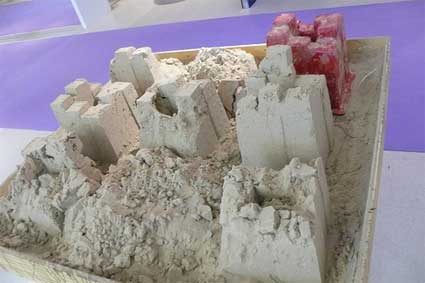
Models for a Sand Castle City
“Progress and catastrophe are opposite faces of the same coin” – Hannah Arendt
Tony Mullin designed buckets for the beach shaped like iconic buildings from the urban landscape, there is the Manhattan apartment block, the Empire State building, a famous Dubai hotel, etc.
The image of a kid building a sand castle evokes innocence. But what happens if a sand building that looks like it comes right from our urban landscape is crushed by feet or swept away by the sea? Would we still find it sweet or potentially subversive? How much has our perception of a disaster been modified by 9/11 and Hurricane Katrina?
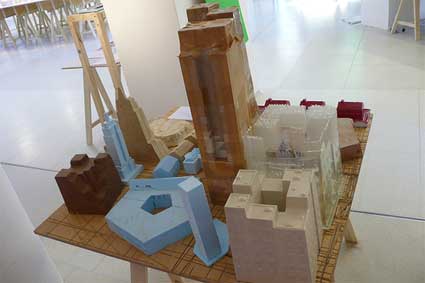
Designing a Protest
The Serious Organized Crime and Police Act 2005 prohibits anyone staging spontaneous protests within a 1km radius of Westminster’s Houses of Parliament. However, Tony Mullin found a loophole in the law. You can carry placards around those no-protest zones as long as they do not carry any slogan.
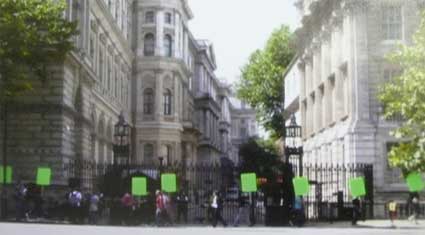
On the 20th of June 2007 the students led a group of volunteers on a walk through the exclusion zone carrying blank green placards. Using Green screen technology, he has been exploring how to invite others to add the ‘political content’ during broadcasting. Basically, the idea is to create a service enabling protesters to use the footage of people carrying the blank placards around the House of Parliaments and add their message onto it afterwards. The video could then be distributed on you tube and other media.
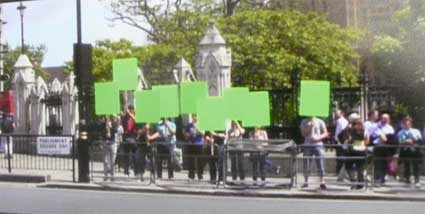
David pumpe by iron pumper
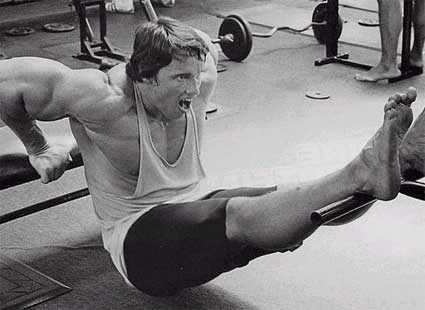
Arnold training (image)
Lucia Massari gave the best introduction to her project one can dream of: a quote from Arnold Schwarzenegger, Encyclopedia of modern Bodybuilding.
Competitive body-builders use body-building techniques to develop their physiques to a degree human beings have never been able to achieve before, and then compete with one another to determine who has reached the highest level of development. Since you can only shape and develop your body in this manner by means of extremely difficult physical effort and precise exercise techniques, body-building must be defined as a sport; but the aesthetic goal of achieving just the right blend of muscularity, symmetry, proportion, and muscle shape, and the need to show it off by a mastery of stage presentation also makes body-building a highly demanding art form.
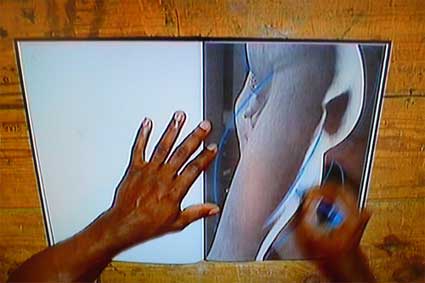
The concept of what is a beautiful body for a bodybuilder is at odds with what we would see as a beautiful body. Lucia hired a bodybuilder -who calls himself “the Iron Pumper”. She then handed him a book containing b&w pictures of one of the most iconic representation of the perfect body: the sculpture of David by Michelangelo. She then asked him to freely comment on it and tell the camera what he thinks of David’s body.
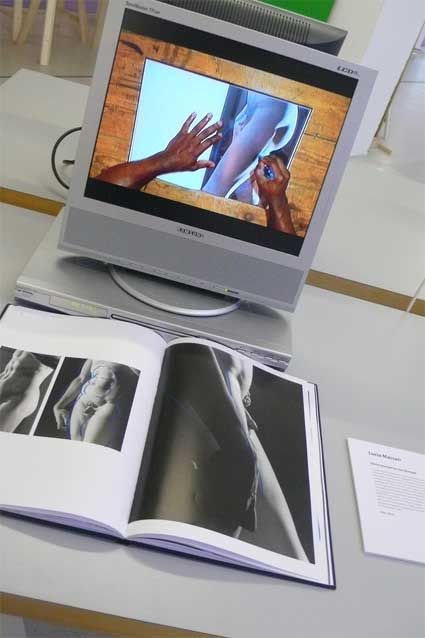
The result is a hilarious video where Iron Pumper criticizes the body and adds a few strokes with a pen on the pages of the book to indicate what the body of a bodybuilder should be like: bottom should be higher, calves should be “more bigger”, biceps ought to be rounder, the cheeks have fat here, etc. My favourite moment is when he draws teeth on David’s face because “you have to give a smile to the judges and show them how happy you are to show your muscles round and nice!” and “wrinkles kick in when you frown like that”.
With Imagine Being a World Leader Dash Macdonald plans to create the framework for a fun and educational role-play exercise that teaches primary school children leadership and public speaking skills.
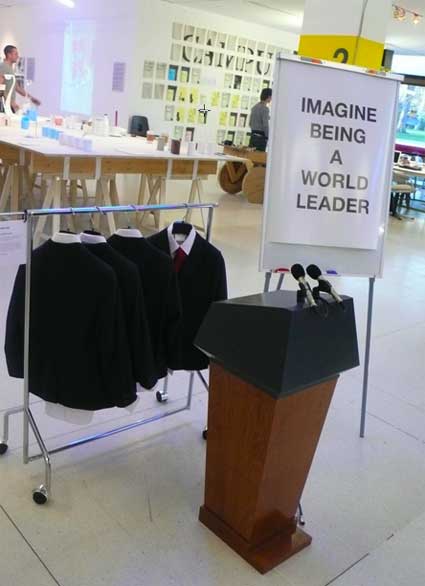
Macdonald built a scale model of a presidential speaking stand, bought a collection of suits for 8 and 9 years old and worked with the school Jubilee Primary School in Hackney. The children will be trained like professionals during workshops by a professional public speaking coach; Ysabel Clare. The workshops will incorporate exercises tailored to teach children key rhetoric rules and text-book gestures. These are vital tools widely used by leaders in the art of successful persuasion, guaranteed to win the attention and approval of an audience. The final project will be a video of their speeches at school. The kids will be able to choose freely what theme they want to put forward during their speech.
Revisiting the community Shed uses design to generate links between a small community with a unique history and a wider audience.
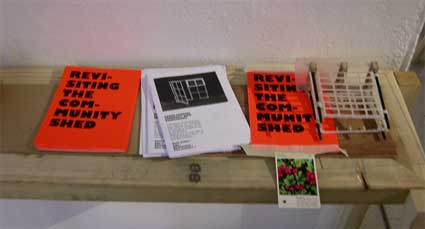
Thomas Pausz met a group of allotments owners and initiated a dialogue about their life at Manor Gardens -a former allotment site which is currently being relocated in the Olympic Legacy Park. He created a brochure where they would describe the “community shed” they had lost. Collectively built, the shed is a place of self initiated democratic dialogue, parties, barbecues and afternoon naps.
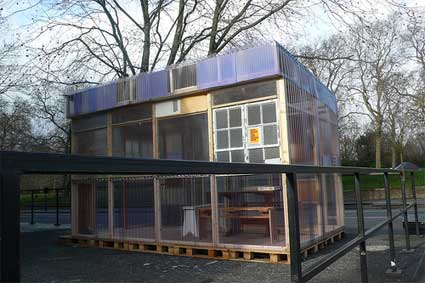
Based on the description of the techniques and materials given by the original users of the shed, and using salvaged architectural parts and wood as well as industrial materials, the student re-built the shed, this time right out of the RCA entrance.
This piece is a celebration of memory, the transmission of design know-how between generations and cultures and of community survival against the odds.
Tom Foulsham si showing some marvelous mad inventor-like mechanisms that he uses in his investigation into drawing with light. No detail on those, i find them too poetically cryptic for that.
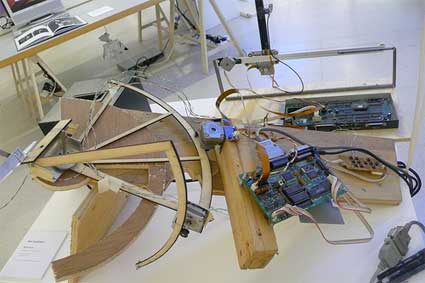
My images.
Related: Interview of Noam Toran.
Just back from London where i visited the Work in Progress show at the Royal College of Art (you’ve got until Thursday 7 February to visit it). I’ll come back with more details later but here’s an appetizer from the department of Design Interactions.
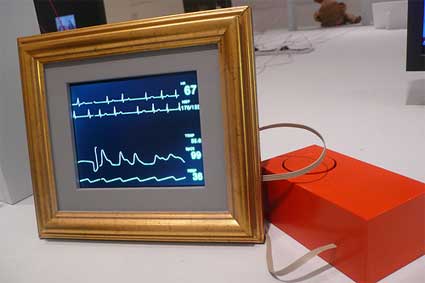
Revital Cohen got interested in Life support machines and the way the technologies involved in keeping patients alive in intensive care enter and merge with the body. By doing so they redefine its material and functional properties. As the human anatomy gains technological capabilities, where does the body end and the machine begin?
The Telepresence Frame is a domestic object which utilizes the fact that one’s bodily functions are digitalized in order to create a new form of telepresence. Your family would have the frame at home as a presence that keeps them constantly aware of your physical state while you’re being kept alive at the hospital.
The Human Black Box records and stores this information, keeping a record of your very last moments. Once you die, the frame plays your life data back. In loop.